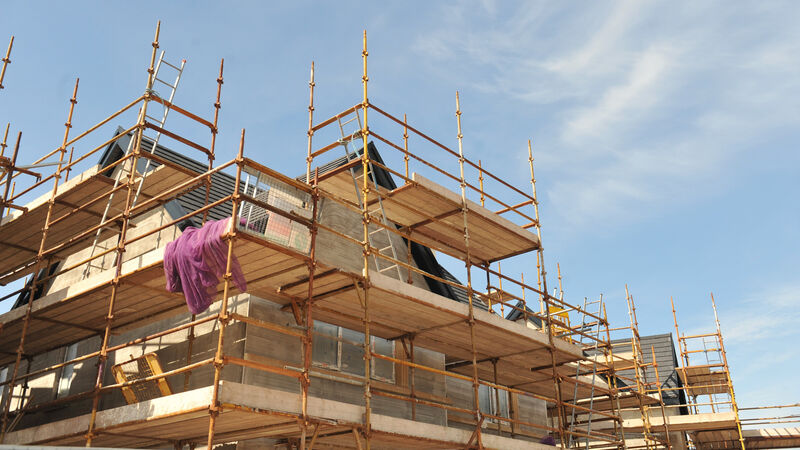Michael Clifford: Has the State the tools needed to build houses?

On Monday, councillors in Dublin City rejected a plan to develop private houses on public land. This may well signal that greater emphasis is to be put on public housing, and less on following the vagaries of the market. Picture Larry Cummins
A small wind of change blew through the housing sector this week. On Monday, councillors in Dublin City rejected a plan to develop private houses on public land. This may well signal that greater emphasis is to be put on public housing, and less on following the vagaries of the market.
The councillors voted overwhelmingly against going ahead with a plan to build 853 homes on Oscar Traynor Road in Santry on the northside of the city, near the entrance to the Port Tunnel.
The deal would have involved selling the land to Glenveagh Properties for around a third of the market value. Glenveagh would then build the homes, with half being sold on the open market, 172 for affordable housing, and 253 bought by the council for social housing.
For most of the councillors – apart from Fine Gael members and a few others – this was wrong, philosophically and practically. The developer would make a nice killing on it and at least half of the homes on public land would not be used to alleviate the chronic shortage of public housing. In the end the plan was shot down by a vote of 48 to 14.
When the plan to sell this site, along with two others in the city, was first raised in the council in 2017, 53 of the 63 councillors voted in favour.
After Monday’s vote, Social Democrats housing spokesperson and local TD Cian O’Callaghan said that he hopes it signals a new direction for housing policy.
“The message is clear,” he said. “People want to see housing that is affordable on public land.
“The result of the councillors’ vote should be a wakeup call for the council executive and the Department of Housing. Proposals that do not maximise the number of cost rental, social and affordable purchase homes on state-owned land will not be passed.
“Future proposals for this site and others must be shaped by this decision.”
Nationally, the councillors' vote is in tune with the changing winds. For instance, ahead of the formation of the current government both the Greens leader Eamon Ryan and the current Minister for Housing Darragh O’Brien spoke of a commitment to public housing on public land.
All of the opposition parties are in favour of the concept. The only party that has reservations is Fine Gael.
When the Santry plan was first proposed in 2017, then housing minister, Fine Gael’s Eoghan Murphy was a major advocate for it. Notably, the current minister, Mr O’Brien, kept a low profile in the run-up to Monday’s vote, not taking any vocal position on the matter.
So all the indications are that from now on large state-owned sites – particularly in cities – will be geared towards providing public and affordable housing with little or no element going to the private sector.
While many will welcome this shift, particularly in terms of fairness, it does present some serious challenges. We know that the private sector can develop large sites. Can the same be said for the public sector today?
In theory, it shouldn’t be a problem. Put a contract out to tender and get the damned thing built. After all, that, along with direct labour from local authorities, was how major public housing schemes were completed in the middle decades of the last century.
But the State got out of major housing builds over 30 years ago. Is there a way back?
“In an ideal world there is nothing to stop it,” according to one developer who doesn’t want to be named. “That’s the way it should be but go ahead and try it. Look at the Children’s Hospital. Some of that is down to complicated infrastructure but more of it is because it’s a direct state contract. It’s the intangibles, the things that arise once you get started. And I’m not just talking about cost. The other thing is time.”
The comment could well be filed under “he would say that, wouldn’t he” coming from a sector which would be making money off public land. However, a similar attitude can be detected among local authority executives.
At Monday night’s meeting on the Santry plan, the council’s head of housing, Brendan Kenny, was strongly in favour. He told councillors that the homes were “badly needed”, particularly as the immediate area has the largest housing waiting list in the State. He said it could be up to eight years before the opportunity arose again to develop the site.
Mr Kenny’s obvious primary concern is to get houses built. His attitude is replicated in local authority executives across the State. Some might ascribe this attitude to a wish to stay clear of the hassles involved in the direct management of builds.
But it is also the case that State officials know precisely the problems with project management, particularly in a system in which local authorities have been starved of resources and expertise over recent decades.
Now the political winds have changed in respect of housing. There is broad agreement that the crisis demands more direct focus on housing needs and less reliance on the market. But getting the State apparatus to respond is going to be difficult.
Housing associations have shown on a small scale how it is possible to build efficiently for communities. There are mixed views on whether that model can be ramped up for large-scale projects. But major focus is now required to ensure that the State can, by one way or another, build public and affordable housing without having to go to the market cap in hand.
This will involve tackling the practicalities.
Why would Mr Kenny estimate that it could take eight years to get the Santry site back on track? What are the roadblocks? Where can elected politicians make a difference?
How can the bureaucracy in the Department of Housing be minimised?
What legal mechanisms are required to ensure that contracted builders don’t go to town on small problems, squeezing a few extra euro from the taxpayer? How much better resourced should local authorities be?
All of these issues are messy and require perseverance on the part of politicians and public servants. But that’s what is needed if reliance for public and affordable housing is to move away from the market.
Retreating from direct state management in the building of houses, as happened over the last 30 years, was the easy bit. Local authorities have been tiptoeing back to it in the last few years.
Returning full throttle to it will be far more difficult and will require major political will, energy, and perseverance.
Let’s see who is up for it.






